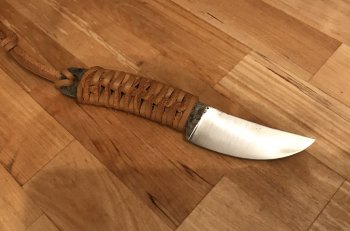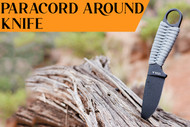Wrapping Paracord Around a Knife Handle
Posted by SwordsSwords on Sep 4th 2023
Have you ever wanted to customize the look and feel of your knife while also improving its functionality? Wrapping paracord around the handle is a simple way to do just that.
Paracord is incredibly versatile, and one of its many uses is enhancing the grip of a knife handle.
The texture provided by paracord wrap makes knives easier to hold onto, especially important for outdoor enthusiasts.
Whether you're processing kindling in the backcountry or performing everyday tasks around the home, a handle paracord wrap provides a surer grip in any conditions.
In this blog post, we will guide you on how to wrap a paracord around a handle. By following these steps, you can transform your knife and improve its performance in minutes.
If you love all things paracord, swordsswords.com has an awesome collection of paracord bracelets and keychains, ON SALE! Be sure to check them out!
Make a Loop
The first step in making a paracord knife wrap is to form a loop using the paracord that goes parallel with the length and width of the handle. Secure the loop to one side of the handle. Place the curve right at the bottom of the handle. Overall, the paracord length should be approximately five times longer than the handle length keeping the loop in the middle of the cord.
Cover the Left End
Now start wrapping from the left end of the cord all the way around the handle. As soon as it reaches the middle of the original loop, slip the end underneath the connection and below the cord
Cover the right end of the cord around the distance across the handle. Put it in the space among all three sections facing forward.
Turn and Repeat
Turn and replicate the entire length of the handle. Make sure the rest of the handle is perfectly covered by following the same wrapping steps. As soon as you repeat the process twice, revolve the knife at 180 degrees. Fundamentally, each set is performed upside-down.
Weave in the Finishes
As you reach the foot of the blade, it’s time to weave the two final ends back into multiple layers. Keep on wrapping the paracord at the lowermost of the handle.
Secure a Knot
For additional security, carry two ends around the knife handle’s backbone and secure them flawlessly into a tight knot. Cut down any excess as per the requirement.
If you are looking forward to making a handle loop, all you need to do is knot the ends together close to their tips as an alternative to securing them near the handle.
Paracord Wrapping Techniques
There are a few different techniques for wrapping paracord around a knife handle to improve grip.
The most common methods are the spiral wrap, diagonal wrap, and ladder stitch. Each has its advantages and produces a slightly different aesthetic on the handle.
The spiral paracord knife wrap is one of the simplest paracord wrapping techniques. It involves wrapping the cord tightly around the handle in a continuous spiral pattern.
This technique provides excellent grip coverage across the entire surface of the handle. It's also quick and easy to do.
However, the spiral wrap may not be as durable long-term as other styles. For a wrap that is less prone to loosening over time and heavy use, try the diagonal or ladder stitch techniques instead.
How to Wrap a Sword Handle
A traditional Japanese sword handle wrapping technique is called tsukamaki wrap. Here’s how to do it.
- To perform the tsukamaki wrap, begin by measuring and cutting your paracord as for other techniques.
- Starting near the pommel, wrap the cord tightly around the handle with overlapping figure-eight loops moving towards the guard.
- Each new loop should pass under the handle, over the previous wrap, and back under itself before tightening.
This interweaving pattern results in excellent grip security. It also adds aesthetic appeal that pays homage to classic samurai sword designs.
While more complex than a simple spiral, the tsukamaki technique is well worth learning if you want an especially durable and authentic paracord wrap for your sword handle.
Parachute Cord Wrapping Techniques
Parachute cord, also called 550 cord, is a heavy-duty type of paracord often used for high-strength applications like structural rigging. Its thicker construction makes it suitable for wrapping larger items that require extra durability and support.
Common objects wrapped with parachute cord include tool and weapon handles. The techniques for wrapping parachute cord are similar to regular paracord but require more tension due to the stiffer material.
Two effective parachute cord wrapping styles are the spiral wrap and Solomon bar. The spiral wrap provides good coverage but can loosen over time with heavy use.
To counteract this, try a Solomon bar wrap which interweaves the cord in a figure-eight pattern up the length of the handle. This distributes pressure more evenly for enhanced grip and less slippage. It creates a burlier, tighter wrap compared to a simple spiral.
For handles that will endure rugged outdoor or tactical use, a Solomon bar or similar tight-weave wrap with parachute cord is the ideal choice.
Leather Wrapping a Knife Handle

Wrapping a knife handle with leather provides an elegant, customizable grip. Leather develops a smooth patina over time and use that improves its performance. It also protects the handle from wear and environmental damage. There are different methods for crafting a leather wrap suited to any knife style.
- A simple wrap can be made from a single strip of leather wrapped spirally around the handle. For added flair, try a stacked leather wrap.
- Cut multiple narrow strips of leather and wrap them together around the handle, overlapping as you go.
- The stacked strips create subtle texture. You can also wrap leather and then add decorative stitching or tooling.
By choosing high-quality leather and employing proper wrapping techniques, you'll end up with a handle that looks broken-in from the start yet will only improve with age.

